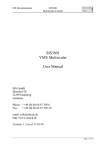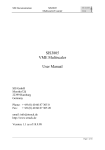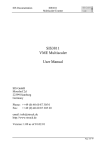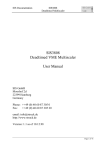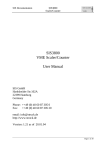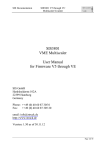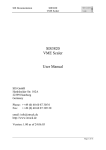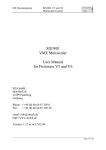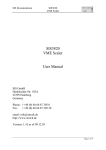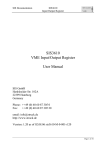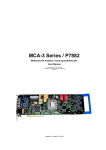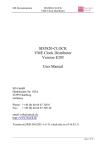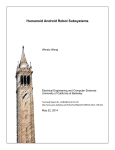Download SIS3600 VME Multi Event Latch User Manual
Transcript
SIS Documentation SIS3600 Multi Event Latch SIS3600 VME Multi Event Latch User Manual SIS GmbH Harksheiderstr.102A 22399 Hamburg Germany Phone: ++49 (0) 40 60 87 305 0 Fax: ++49 (0) 40 60 87 305 20 email: [email protected] http://www.struck.de Version: sis3600-M-0-1-v126 as of 17.07.07 Page 1 of 44 SIS Documentation SIS3600 Multi Event Latch Revision Table: Revision 1.0 1.1 1.11 Date 1.12 08.07.99 1.13 1.20 25.10.99 01.02.01 1.21 1.22 1.23 1.24 1.25 02.02.01 14.06.02 24.11.03 08.01.04 16.02.06 1.26 17.07.07 Page 2 of 44 08.12.98 06.07.99 Modification Generation fast clear revision table bug fix in output mode table coincidence mode input timing bug fix in coincidence mode timing diagram bug fix in default settings of control register Firmware Version 2, no Broadcast functionality, CBLT style data readout CBLT hints added Bug fix in input/output section Bug fix, fast clear register is write only Remove D16 in FIFO read access ESD note added Minimum LNE length increased to 25ns (from 10 ns) Enable external next added to getting started sequence SIS Documentation SIS3600 Multi Event Latch 1 Table of contents 1 2 3 Table of contents............................................................................................................................................. 3 Introduction..................................................................................................................................................... 5 Technical Properties/Features ......................................................................................................................... 6 3.1 Board Layout........................................................................................................................................... 6 3.2 Design and Modus Operandi................................................................................................................... 7 3.3 Readout Considerations .......................................................................................................................... 8 4 Getting Started ................................................................................................................................................ 9 4.1 Factory Default Settings.......................................................................................................................... 9 4.1.1 Adressing ........................................................................................................................................ 9 4.1.2 Firmware Design............................................................................................................................. 9 4.1.3 System Reset Behaviour................................................................................................................ 10 5 Firmware Selection ....................................................................................................................................... 10 5.1 Examples............................................................................................................................................... 10 Front Panel LEDs.................................................................................................................................................. 11 6 VME addressing............................................................................................................................................ 12 6.1 Address Space ....................................................................................................................................... 12 6.2 Base Address......................................................................................................................................... 12 6.2.1 VME.............................................................................................................................................. 12 6.2.2 VIPA/VME64x ............................................................................................................................. 12 6.3 Address Map ......................................................................................................................................... 13 7 Register Description...................................................................................................................................... 14 7.1 Status Register (0x0) ............................................................................................................................. 14 7.2 Control Register (0x0)........................................................................................................................... 15 7.3 Module Identification and IRQ control register (0x4)........................................................................... 16 7.4 Fast Clear Window register 0x8............................................................................................................ 17 7.5 Frequency register 0xC ......................................................................................................................... 17 7.6 CBLT setup register 0x80 (R/W) .......................................................................................................... 18 7.7 FIFO (0x100-0x1FC) ............................................................................................................................ 19 8 Broadcast Addressing (version 1 only) ......................................................................................................... 20 9 VME Interrupts ............................................................................................................................................. 21 10 Data Format............................................................................................................................................... 22 10.1.1 D16................................................................................................................................................ 22 10.1.2 D32................................................................................................................................................ 22 11 Input Configuration................................................................................................................................... 23 11.1 ECL ....................................................................................................................................................... 23 11.2 NIM....................................................................................................................................................... 24 11.3 TTL ....................................................................................................................................................... 25 11.3.1 TTL/LEMO ................................................................................................................................... 25 11.3.2 TTL/Flat Cable.............................................................................................................................. 25 12 Connector Specification ............................................................................................................................ 25 13 Control Output Modes............................................................................................................................... 26 13.1 Outputs.................................................................................................................................................. 26 13.2 Inputs..................................................................................................................................................... 26 14 Signal Specification .................................................................................................................................. 27 14.1 Control Signals...................................................................................................................................... 27 14.2 Inputs..................................................................................................................................................... 27 14.2.1 Strobed Mode Input Timing.......................................................................................................... 27 14.2.2 Coincidence Mode Input Timing .................................................................................................. 27 14.3 Outputs.................................................................................................................................................. 28 14.3.1 Input to FAST OR Output Timing ................................................................................................ 28 14.3.2 Copy in progress (CIP).................................................................................................................. 28 15 Operating conditions ................................................................................................................................. 29 15.1 Power Consumption/Voltage requirement ............................................................................................ 29 15.2 Cooling.................................................................................................................................................. 29 15.3 Insertion/Removal ................................................................................................................................. 29 16 Test............................................................................................................................................................ 30 16.1 LED (selftest)........................................................................................................................................ 30 Page 3 of 44 SIS Documentation SIS3600 Multi Event Latch 16.2 Output pulser test .................................................................................................................................. 30 16.3 FIFO Test .............................................................................................................................................. 30 17 Software Support....................................................................................................................................... 31 17.1 Contents of the included Floppy ........................................................................................................... 31 18 Appendix................................................................................................................................................... 32 18.1 Address Modifier Overview.................................................................................................................. 32 18.2 Front Panel Layout................................................................................................................................ 33 18.3 List of Jumpers...................................................................................................................................... 34 18.4 Jumper and rotary switch locations ....................................................................................................... 34 18.4.1 Addressing mode and base address selection................................................................................ 34 18.4.2 J500 (Bootfile Selection) and J520 (SYSRESET Behaviour)....................................................... 35 18.5 Board Layout......................................................................................................................................... 36 18.6 CBLT readout ....................................................................................................................................... 37 18.6.1 CBLT Setup example .................................................................................................................... 38 18.6.2 CBLT hints.................................................................................................................................... 39 18.7 Cascaded FIFOs .................................................................................................................................... 40 18.8 FLASHPROM Versions........................................................................................................................ 40 18.9 Row d and z Pin Assignments............................................................................................................... 41 18.10 Geographical Address Pin Assignments ........................................................................................... 42 18.11 Additional Information on VME....................................................................................................... 42 19 Index ......................................................................................................................................................... 43 Page 4 of 44 SIS Documentation SIS3600 Multi Event Latch 2 Introduction The SIS3600 is the multi event latch of the SIS360x/38xx VME board family. It can be operated in strobed or coincidence mode. One can also refer to the unit as 32-bit pattern unit. The SIS3600 is a single width (4 TE) 6U (double euro form factor) card. It was designed to capture the status of the outputs of discriminators or other front end electronics. An other application is the high speed readout of position or angular encoders, as no slow serial protocol like SSI (serial synchronous interface) is involved. Due to the fast OR output the unit can be used for the generation of higher level trigger decisions. A fast clear window allows the use of the latch in conjunction with 2nd level trigger electronics. Another application of the module comprises the acquisition of TTL, NIM or ECL data streams with some 20 MB/s. Due the FIFO architecture with up to 128 K longwords the following transfer to the system controller is decoupled from the incoming data stream. This document was written with the focus on the user of the unit, who wants to integrate the board into a data acquisition system and interested parties who consider the module for future use in their setup and would like to get an overview on the designs capabilities. The SIS360x/38xx card is a flexible concept to implement a variety of latch and counter firmware designs. The flexibility is based on two to six Xilinx FPGAs in conjunction with a FLASHPROM from which the firmware files are loaded into the FPGAs. Depending on the stuffing options of the printed circuit board, the user has the possibility to cover several purposes with the same card, hence the manual is a combination of firmware and hardware description . All cards of the family are equipped with the 5 row VME64x VME connectors, a side cover and EMC front panel, as well as the VIPA LED set. For users with VME64xP subracks VIPA extractor handles can be installed. The base board is prepared for VIPA style addressing, the current first version of the SIS3600 firmware does not feature VIPA modes yet however. As we are aware, that no manual is perfect, we appreciate your feedback and will try to incorporate proposed changes and corrections as quickly as possible. The most recent version of this manual can be obtained by email from [email protected], the revision dates are online under http://www.struck.de/manuals.htm. A list of available firmware designs can be retrieved from http://www.struck.de/sis3638firm.htm Page 5 of 44 SIS Documentation SIS3600 Multi Event Latch 3 Technical Properties/Features The SIS3600 is rather a firmware design in combination with given board stuffing options, than a name for the board (this is the reason, why the modules are named SIS360x/38xx on the front panel and the distinction of the units is made by the module identifier register). The firmware makes use of part of the possibilities of the SIS360x/38xx PCB, if the SIS3600 or other firmware designs of the family come close to what you need, but something is missing, a custom firmware design may be an option to consider. Find below a list of key features of the SIS3600. • 32-bit • NIM/TTL/ECL versions • flat cable (TTL/ECL) and LEMO (TTL/NIM) versions • 64K (32K Event) FIFO (256K available on request) • A16/A24/A32 D16/D32/BLT32 (CBLT32 with firmware version 2) • broadcast functionality (with firmware version 1) • user output bit • fast OR output • fast clear • Base address settable via 5 rotary switches (A32-A12) and one jumper (A11) • VME interrupt capability • VIPA geographical addressing prepared • VIPA LED set • 100 ns minimum cycle time • Pulser capability • Up to eight firmware files • single supply (+5 V) 3.1 Board Layout Xilinx FPGAs are the working horses of the SIS360x/38xx board series. The counter (prescaler, latch, ...) logic is implemented in one to four chips, each chip handles eight front end channels. The VME interface and the input and output control logic reside in two Xilinx chips also. The actual firmware is loaded into the FPGAs upon power up from a FLASHPROM under jumper control. The user can select among up to eight different boot files by the means of a 3-bit jumper array. The counter inputs, the control inputs and the outputs can be factory configured for ECL, NIM and TTL levels. The front panel is available as flat cable (ECL and TTL) or LEMO (NIM and TTL) version. The board layout is illustrated with the block diagram below: Page 6 of 44 4 4 SIS3600 Multi Event Latch Level Adaption Driver/Receiver Level Adaption Driver/Receiver Control XILINX VME Interface XILINX VME Bus SIS Documentation FIFO 4 4 4 Level Adaption Driver/Receiver Level Adaption Driver/Receiver Level Adaption Driver/Receiver 4 Level Adaption Driver/Receiver 4 Level Adaption Driver/Receiver 4 Level Adaption Driver/Receiver 4 4 Level Adaption Driver/Receiver Level Adaption Driver/Receiver Counter XILINX FLASH PROM Counter XILINX File Selection Counter XILINX Counter XILINX SIS3600 Block Diagram 3.2 Design and Modus Operandi The latches are implemented in XILINX FPGAs. One of the latch FPGAs holds 8 channels (bits). The multi event capability is achieved with a FIFO. Data are copied from the frontend latch chips to the FIFO and can be read via the VMEBus asynchronous. The duration of the frontend to FIFO copy process is available on the Copy In Progress (CIP) front panel output for synchronisation of external hardware. The CIP signal allows the user also to check the minimum possible gap between two consecutive events, this was measured to be some 100 ns. If fast clear is enabled via the control register, data are copied to the FIFO if no external fast clear signal arrives within the programmed fast clear window, events with fast clear are skipped. A side effect of the short copy to FIFO time is, that the SIS3600 latch can be used as a FIFO between ECL data streams and the VMEbus with input data rates in excess of 30MB/s in applications where no event structure or special requirements like the presence of an independent DSP readout bus are required. Page 7 of 44 SIS Documentation SIS3600 Multi Event Latch 3.3 Readout Considerations One of the major advantages of a FIFO based latch is the decoupling of the front end readout and the actual VME readout of the data. Depending on the application the FIFO may be used to buffer one or two reads only, before a DSP processes the data on the fly, in this case the FIFO is used to establish readout pipelining, in other cases the maximum possible FIFO size is of interest to store a complete set of data points for a pulsed or non continuous measurement. Continuous readout can be established as long as the VME master can cope with the amount of data generated by the latch, i.e. the FIFO is never allowed to run into the FIFO full condition. The 64K default FIFO size of the SIS3600 is considered to be a save value for most applications, for more demanding applications the FIFO size can be increased to 256K. One as to keep in mind, that two FIFO words are needed to hold one 32-bit latch value, i.e. a 64K FIFO can hold 32K latch words (or events). The packing of the FIFO data into VME D32 words is handled without user intervention upon VME read cycles from the FIFO. In high data rate applications, the readout scheme will make use of the FIFO half full flag via a VME interrupt or polling in most cases, as a minimum known number of 32K longwords can be read out (being blocked into smaller chunks by VME) with a block transfer. Example: Assume the latch is read out with a frequency of 1 MHz, the data rate is 4 MB/s and the FIFO half full interrupt or flag will be asserted for the first time after some 15 ms of data acquisition and the VME master has to digest 64Kbytes within less than 15 ms (including IRQ handling or polling) to prevent the FIFO from overflow. Note: No new data can be acquired before a FIFO reset if the FIFO full condition has occurred (i.e. the FIFO full condition is considered an error condition, which should not occur in standard operation). Page 8 of 44 SIS Documentation SIS3600 Multi Event Latch 4 Getting Started The minimum setup to operate the SIS3600 in strobed mode without the use of the fast clear capability requires the following steps: • Check the proper firmware design is selected (should be design zero, i.e. all jumpers of jumper array J500 set. • Select the VME base address for the desired addressing mode • Select the VME SYSRESET behaviour via J520 • turn the VME crate power off • install the latch in the VME crate • connect your signals to the latch • turn crate power back on • issue a key reset by writing to 0x60 • issue FIFO clear by writing to 0x20 • configure CBLT setup register as needed (firmware version 2 only) • enable next logic by writing to 0x28 • set bit 16 of control register 0x0 to enable external LNE pulses • issue first next clock pulse to start counting by soft- or hardware • after one or more subsequent next clock pulses data can be read from the FIFO from the addresses 0x100 through 0x1FC. A good way of checking first time communication with the SIS3600 consists of switching on the user LED by a write to the control register at offset address 0x0 with data word 0x1 (the LED can be switched back off by writing 0x100 to the control register).. 4.1 Factory Default Settings 4.1.1 Adressing SIS3600 boards are shipped with the En_A32, the En_A24 and the En_A16 jumpers installed and the rotary switches set to: Switch Setting SW_A32U SW_A32L SW_A24U SW_A24L 3 8 3 8 SW_A16 3 J A_11 8 Bits 7-4 0 Bits 3-0 0 Jumper A_11 is open (bit 11 set). Hence the unit will respond to the following base addresses: Mode A32 A24 A16 Base address 0x38383800 0x383800 0x3800 4.1.2 Firmware Design Design 0 (SIS3600, Version 1) of the FLASHPROM is selected (all jumpers of jumper array J500 closed). Page 9 of 44 SIS Documentation SIS3600 Multi Event Latch 4.1.3 System Reset Behaviour J520 is set, i.e. the SIS3600 is reset upon VME reset. 5 Firmware Selection The FLASH PROM of a SIS360x/38xx board can contain several boot files. A list of available FLASHPROM versions can be found on our web site http://www.struck.de in the manuals page. If your FLASHPROM has more than one firmware design, you can select the desired firmware via the firmware selection jumper array J500 . You have to make sure, that the input/output configuration and FIFO configuration of your board are in compliance with the requirements of the selected firmware design (a base board without FIFO can not be operated as multi channel scaler e.g.). A total of 8 boot files from the FLASHPROM can be selected via the three bits of the jumper array. The array is located towards the rear of the card between the VME P1 and P2 connectors. The lowest bit sits towards the bottom of the card, a closed jumper represents a zero, an open jumper a one. 5.1 Examples The figures below show jumper array 500 with the soldering side of the board facing the user and the VME connectors pointing to the right hand side. Bootfile 0 selected With all jumpers closed boot file 0 is selected Bootfile 3 selected With the lowest two jumpers open bit 0 and bit 1 are set to 1 and hence boot file 3 is selected Page 10 of 44 SIS Documentation SIS3600 Multi Event Latch Front Panel LEDs The SIS3600 has 8 front panel LEDs to visualise part of the units status. Three LEDs according to the VME64xP standard (Power, Access and Ready) plus 5 additional LEDs. Designation A P R U CLR OVL (CIP) S VU LED Access Power Ready VME user LED Copy in Progress VIPA user LED Color yellow red green green yellow red green green Function with SIS3600 design Signals VME access to the unit Flags presence of VME power Signals configured logic To be switched on/off under user program control Fast clear Signals copy in progress Enabled for future use The LED locations are shown in the portion of the front panel drawing below. The VME Access, the Clear LED are monostable (i.e. the duration of the on phase is stretched for better visibility), the other LEDs reflect the current status. An LED test cycle is performed upon power up (refer to chapter 16.1). Page 11 of 44 SIS Documentation SIS3600 Multi Event Latch 6 VME addressing 6.1 Address Space As bit 11 is the lowest settable bit on the 360x/38xx board, an address space of 2 Kbytes (Offset plus 0x000 to 0x7ff) is occupied by the module. 6.2 Base Address 6.2.1 VME The VME addressing mode (A16/A24/A32) is selected via the jumpers EN_A16, EN_A24 and EN_A32.The mode is selected by closing the corresponding jumper, it is possible to enable two or all three addressing modes simultaneously. The base address is set via the five rotary switches SW_A32U, SW_A32L, SW_A24U, SW_A24L and SW_A16 and the jumper J_A11. The table below lists the switches and jumpers and their corresponding address bits. Switch/Jumper SW_A32U SW_A32L SW_A24U SW_A24L SW_A16 J_A11 Affected Bits 31-28 27-24 23-20 19-16 15-12 11 In the table below you can see, which jumpers and switches are used for address decoding in the three different addressing modes (fields marked with an x are used). A32 A24 A16 SW_A32U x SW_A32L x SW_A24U x x SW_A24L x x SW_A16 x x x J_A11 x x x Note: J_A11 closed represents a 0, J_A11 open a one 6.2.2 VIPA/VME64x As the VME64x and the VME64xP (VIPA) standard are not yet standards to refer to and to declare conformity with, addressing modes (like geographical addressing e.g.) according to these standards are prepared but not yet implemented in the current firmware revisions. Page 12 of 44 SIS Documentation SIS3600 Multi Event Latch 6.3 Address Map The SIS360x/38xx boards are operated via VME registers, VME key addresses and the FIFO (where installed). The following table gives an overview on all SIS3600 addresses and their offset from the base address, a closer description of the registers and their function is given in the following subsections. Part of the addresses are present in firmware version 1 or 2 only, access to the address with the wrong firmware loaded will result in a bus error. Offset 0x000 0x004 0x008 0x00C 0x010 0x020 0x024 0x028 0x02C 0x030 0x034 0x038 0x03C 0x050 0x054 0x060 0x068 0x080 0x1000x1FC Key KA KA KA KA KA KA KA KA KA KA KA KA Access R/W R/W W W W W W W W W W W W W W W W R/W R Type D16/D32 D16/D32 D16/D32 D16/D32 D16/D32 D16/D32 D16/D32 D16/D32 D16/D32 D16/D32 D16/D32 D16/D32 D16/D32 D16/D32 D16/D32 D16/D32 D16/D32 D16/D32 D32/ BLT32 Function Control and Status register Module Identification and IRQ control register 8-bit fast clear window value Output pulse frequency register Write to FIFO (in FIFO test mode) clear FIFO and logic VME next clock Enable next clock logic Disable next clock logic Broadcast, clear FIFO and logic (Version 1 only) Broadcast; VME next clock (Version 1 only) Broadcast; Enable next clock logic (Version 1 only) Broadcast; Disable next clock logic (Version 1 only) Enable fast clear Disable fast clear reset register (global reset) Generate one output pulse CBLT setup register (Version 2 only) read FIFO Note: D08 is not supported by the SIS360x/38xx boards The shorthand KA stands for key address. Write access with arbitrary data to a key address initiates the specified function Page 13 of 44 SIS Documentation SIS3600 Multi Event Latch 7 Register Description 7.1 Status Register (0x0) The status register reflects the current settings of most of the SIS3801 parameters in read access, in write access it functions as the control register. Bit 31 30 29 28 27 26 25 24 23 22 21 20 19 18 17 16 15 14 13 12 11 10 9 8 7 6 5 4 3 2 1 0 Function Status VME IRQ source 3 (FIFO full) Status VME IRQ source 2 (FIFO half full) Status VME IRQ source 1 (FIFO almost empty) Status VME IRQ source 0 (start of CIP) VME IRQ internal VME IRQ 0 0 Status VME IRQ Enable Bit Source 3 Status VME IRQ Enable Bit Source 2 Status VME IRQ Enable Bit Source 1 Status VME IRQ Enable Bit Source 0 Status coincidence mode (0=strobed, 1=coincidence) Status latch gate Status enable external clear Status enable external next Status Enable next logic Status fast clear (0=fast clear disabled, 1=fast clear enabled) 0 FIFO flag full FIFO flag almost full0 FIFO flag half full FIFO flag almost empty FIFO flag empty Status broadcast mode handshake controller Status broadcast mode Status pipe mode Status enable output pulses Status output mode bit 1 Status output mode bit 0 Status FIFO test mode Status user LED/user output The reading of the status register after power up or key reset is 0x300 (see default settings of control register). Page 14 of 44 SIS Documentation SIS3600 Multi Event Latch 7.2 Control Register (0x0) The control register is in charge of the control of most of the basic properties of the SIS3600 board in write access. It is implemented via a selective J/K register, a specific function is enabled by writing a 1 into the set/enable bit, the function is disabled by writing a 1 into the clear/disable bit (which has a different location within the register). An undefined toggle status will result from setting both the enable and disable bits for a specific function at the same time. On read access the same register represents the status register. Bit 31 30 29 28 27 26 25 24 23 22 21 20 19 18 17 16 15 14 13 12 11 10 9 8 7 6 5 4 3 2 1 0 Function disable IRQ source 3 (*) disable IRQ source 2 (*) disable IRQ source 1 (*) disable IRQ source 0 (*) clear coincidence mode (*) clear latch gate (*) disable external clear (*) disable external next (*) enable IRQ source 3 enable IRQ source 2 enable IRQ source 1 enable IRQ source 0 set coincidence mode set latch gate enable external clear enable external next disable broadcast mode handshake controller (*) disable broadcast mode (*) disable pipeline mode (*) (see note below table also) disable output pulses (*) clear output mode bit 1 (*) clear output mode bit 0 (*) disable FIFO test mode switch off user LED (and user output with output mode=2) (*) enable handshake controller for broadcast mode enable broadcast mode enable pipeline mode (see note below table also) enable output pulses set output mode bit 1 set output mode bit 0 enable FIFO test mode switch on user LED (and user output with output mode=2) (*) denotes the default power up or key reset state Note 1: Pipeline mode was established to facilitate the use of the SIS3600 in conjunction with SIS38xx multiscalers. As the first next pulse on a SIS multiscaler does not result in a readout, but in the start of the counting process, pipeline mode can be activated on the SIS3600 latch to achieve the same behaviour. Note 2: set latch gate defines a software gate, which will not be reset until cleared with clear latch gate (i.e. a unit will record all leading edges in coincidence mode, no matter, what LNE length is present). Page 15 of 44 SIS Documentation SIS3600 Multi Event Latch 7.3 Module Identification and IRQ control register (0x4) This register has two basic functions. The first is to give information on the active firmware design. This function is implemented via the read only upper 20 bits of the register. Bits 1631 hold the four digits of the SIS module number (like 3801 or 3600 e.g.), bits 12-15 hold the version number. The version number allows a distinction between different implementations of the same module number, the SIS3801 for example has the 24-bit mode with user bits and the straight 32-bit mode as versions. Bit 31 30 29 28 27 26 25 24 23 22 21 20 19 18 17 16 15 14 13 12 11 10 9 8 7 6 5 4 3 2 1 0 Read/Write access read only read only read only read only Read only read only read only read only read only read only read only read only read only read only read only read only read only read only read only read only read/write read/write read/write read/write read/write read/write read/write read/write read/write read/write read/write read/write Function Module Identification Bit 15 Module Id Digit 3 Module Identification Bit 14 Module Identification Bit 13 Module Identification Bit 12 Module Identification Bit 11 Module Id Digit 2 Module Identification Bit 10 Module Identification Bit 9 Module Identification Bit 8 Module Identification Bit 7 Module Id Digit 1 Module Identification Bit 6 Module Identification Bit 5 Module Identification Bit 4 Module Identification Bit 3 Module Id Digit 0 Module Identification Bit 2 Module Identification Bit 1 Module Identification Bit 0 Version Bit 3 Version Bit 2 Version Bit 1 Version Bit 0 VME IRQ Enable (0=IRQ disabled, 1=IRQ enabled) VME IRQ Level Bit 2 VME IRQ Level Bit 1 VME IRQ Level Bit 0 IRQ Vector Bit 7; placed on D7 during VME IRQ ACK cycle IRQ Vector Bit 6; placed on D6 during VME IRQ ACK cycle IRQ Vector Bit 5; placed on D5 during VME IRQ ACK cycle IRQ Vector Bit 4; placed on D4 during VME IRQ ACK cycle IRQ Vector Bit 3; placed on D3 during VME IRQ ACK cycle IRQ Vector Bit 2; placed on D2 during VME IRQ ACK cycle IRQ Vector Bit 1; placed on D1 during VME IRQ ACK cycle IRQ Vector Bit 0; placed on D0 during VME IRQ ACK cycle The second function of the register is interrupt control. The interrupter type of the SIS3600 is D08(O) . Via bits 0-7 of the module identifier and interrupt control register you can define the interrupt vector, which is placed on the VME bus during the interrupt acknowledge cycle. Bits 8 through 10 define the VME interrupt level, bit 11 is used to enable (bit set to 1) or disable (bit set to 0) interrupting. Page 16 of 44 SIS Documentation SIS3600 Multi Event Latch Module identification and version example: The register for a SIS3801 in straight 32-bit mode (version 1) reads 0x38011nnn, for a SIS3801 in 24-bit mode (version 2) it reads 0x38012nnn. (the status of the lower 3 nibbles is denoted with n in the example). 7.4 Fast Clear Window register 0x8 The 8-bit value, which is stored/written to the lowest 8-bits of this register defines the width of the fast clear window (FCW) if fast clear is enabled. The length of the FCW is defined by: FCW = (8-bit register value +1) x 100 ns + 120 ns Hence the maximum length of the fast clear window is some 25 µs. Events with a leading edge of the fast clear pulse inside of the fast clear window are not copied to the FIFO (i.e. are discarded). The fast clear is armed in the region from 65 to 85 ns after the leading edge of the next signal, for safe operation it is recommended to time the fast clear in a way, that it is arriving 85 ns or more after the next signal (what will be the case with typical trigger logic anyway). 7.5 Frequency register 0xC Depending on the output mode the SIS3600 has up to four outputs which are driven from an internal pulser. These outputs can be routed to the external next input of the unit and additional external units like multiscalers or a readout controller to define the heartbeat of the setup. The frequency register is a 24-bit write only register and it actually defines the ouput pulse interval in steps of 100 ns. A setting of zero corresponds to a pulse gap of 100 ns (i.e. a frequency of 10 MHz), the maximum setting of 0xFFFFFF corresponds to a pulse spacing of some 1.68 s. The width of the output pulse has a constant value of 50 ns. Pulse spacing Pulse width = (24-bit register value +1) x 100 ns = 50 ns Page 17 of 44 SIS Documentation SIS3600 Multi Event Latch 7.6 CBLT setup register 0x80 (R/W) This register defines, whether the SIS3811 will participate in a CBLT. The configuration of this register and the registers of other participating modules is essential for proper CBLT behaviour. Bit 31 30 29 28 27 26 25 24 23 22 21 20 19 18 17 16 15 14 13 12 11 10 9 8 7 6 5 4 3 2 1 0 Function CBLT address bit 31 CBLT address bit 30 CBLT address bit 29 CBLT address bit 28 CBLT address bit 27 CBLT address bit 26 CBLT address bit 25 CBLT address bit 24 0 0 0 0 0 0 0 0 Geographical address bit 4 Geographical address bit 3 Geographical address bit 2 Geographical address bit 1 Geographical address bit 0 0 0 0 0 0 0 0 0 First (to be set to 1 on the first module in the CBLT chain) Last (to be set to 1 on the last module in the CBLT chain) enable CBLT (to be set to 1 on all modules in the CBLT chain) The function/meaning of the CBLT and the geographical address is illustrated in section. 18.6.1. Page 18 of 44 SIS Documentation SIS3600 Multi Event Latch 7.7 FIFO (0x100-0x1FC) The FIFO can be accessed from addresses 0x100 through 0x1FC to facilitate the readout with different types of CPUs. For masters with block transfer capability without address increment its most convenient to read all data from address 0x100. For masters with block transfer address auto increment it is straightforward to set up repeated block reads with a length of 256 Bytes (the maximum VME block transfer size) from address 0x100 (and the autoincrement uses the addresses 0x100 through 0x1FC for the transfer). If FIFO test mode is enabled data can be written to the FIFOs addresses. FIFO test mode is a good method to test the integrity of the FIFO as well as the complete VME readout chain including master and slave drivers and receivers and the VME backplane. Page 19 of 44 SIS Documentation SIS3600 Multi Event Latch 8 Broadcast Addressing (version 1 only) Broadcast addressing is an efficient way to issue the same command to a number of modules. It can be used in A24 and A32 mode on SIS360x/38xx boards. The higher address bits are used to define the broadcast class, the distinction of the modules is done via the A16 rotary switch and the A_11 jumper. If broadcast addressing is used, the A32_U, the A_32_L, the A24_U and the A24_L rotary switches must have the same setting in A32 mode, in A24 mode the A24_U and A24_L setting must be the same on all participating units. One of the participating units must be configured as broadcast handshake controller by setting bit 7 in the units control register. All of the participating units must have set bit 6 (enable broadcast) in the control register. The broadcast time jitter was measured to be less than 40 ns within a VME crate, i.e. you have the possibility issue commands under software control with a maximum uncertainty of 40 ns (like clear all FIFOs), what sure is worse, than a hard wired front panel signal, but is much better than a VME single cycle loop over a number of units. The four broadcast commands are executed via the VME key addresses at offset 0x030 through 0x3C. Note: Broadcast functionality is not implemented on firmware version 2 A32 Broadcast Example: Let four SIS3600 participate by setting the A_32 jumper and setting the base address of the units to: Unit 1: 0x32001000 Unit 2: 0x32001800 Unit 3: 0x32002000 Unit 4: 0x32002800 Switch on enable broadcast by setting bit 6 in the control register of the four units. Enable broadcast handshake controller on unit 4 by setting bit 7 of its control register. An A232 write to address 0x32000034 will issue one software next clock on units 1 through 4. A24 Broadcast Example: Let three SIS3600 participate by setting the A_24 jumper and setting the base address of the units to: Unit 1: 0x541000 Unit 2: 0x542000 Unit 3: 0x543000 Switch on enable broadcast by setting bit 6 in the control register of the three units. Enable broadcast handshake controller on unit 1 by setting bit 7 of its control register. An A24 write to address 0x540030 will clear the FIFOs and the logic on units 1 through 3. Page 20 of 44 SIS Documentation SIS3600 Multi Event Latch 9 VME Interrupts Four VME interrupt sources are implemented in the SIS3600 firmware design: • start of CIP • FIFO half full • FIFO almost full • FIFO full (error condition) The interrupter is of type D8(O). The interrupt logic is shown below. For VME interrupt generation the corresponding interrupt source has to be enabled by setting the respective bit in the VME control register (disabling is done with the sources J/K bit). Interrupt generation has to be enabled by setting bit 11 in the IRQ and version register. The internal VME interrupt flag can be used to check on an IRQ condition without actually making use of interrupts on the bus. The VME interrupt level (1-7) is defined by bits 8 through 10, and the VME interrupt vector (0-255) by bits 0 through 7 of the VME IRQ and version register. In general an interrupt condition is cleared by disabling the corresponding interrupt, clearing the interrupt condition (i.e. clear overflow) and enabling the IRQ again. Note: In most cases your experiment may not require interrupt driven scaler readout, but the interrupt capability of the SIS3600 provides a way to overcome the problem of missing front panel inputs on most commercial VME CPUs. VME_IRQ_ENABLE AND Clear CIP VME IRQ AND Enable 0 Source 0 Full AND Source 1 Enable 1 OR INTERNAL_VME_IRQ Half Full AND Source 2 AND Source 3 Enable 2 Almost Full Enable 3 Page 21 of 44 SIS Documentation SIS3600 Multi Event Latch 10 Data Format The 32-bit latched value is copied into the VME word in a straightforward fashion: 10.1.1 D16 first read second read 10.1.2 D32 Data Bits 31-24 Page 22 of 44 high Byte Data Bits 31-24 Data Bits 15-8 Data Bits 23-16 low Byte Data Bits 23-16 Data Bits 7-0 Data Bits 15-8 Data Bits 7-0 SIS Documentation SIS3600 Multi Event Latch 11 Input Configuration SIS36/38xx boards are available for NIM, TTL and ECL input levels and in LEMO and flat cable versions. The boards are factory configured for the specified input level and connector type, input termination is installed. 11.1 ECL The 100 Ω input termination can be removed in groups of four channels by removing the corresponding resistor networks. The termination of single control inputs can be disabled with jumpers J101 through J108, an open jumper disables the termination of the corresponding channel. Network RN10 RN20 RN30 RN40 RN50 RN60 RN70 RN80 RN110 RN120 Channels 1-4 5-8 9-12 13-16 17-20 21-24 25-28 29-32 Control 1-4 Control 5-8 1 K Networks RN11/12 RN21/22 RN31/32 RN41/41 RN51/52 RN61/62 RN71/72 RN81/82 RN111/RN112 RN121/RN122 The schematics of the ECL input circuitry is shown below. GND SIL RN(1)X1 1K SIL RN(1)X0 + 100 + SIL RN(1)X2 1K -5 V Page 23 of 44 SIS Documentation SIS3600 Multi Event Latch 11.2 NIM The 50 Ω input termination can be removed in groups of four channels by removing the corresponding resistor networks. The termination of single control inputs can be disabled with jumpers J101 through J108, an open jumper disables the termination of the corresponding channel. Network U15 (Pins 10 to 6) U15 (Pins 1 to 5) U35 (Pins 10 to 6) U35(Pins 1 to 5) U55 (Pins 10 to 6) U55 (Pins 1 to 5) U75 (Pins 10 to 6) U75 (Pins 1 to 5) U115 (Pins 10 to 6) U115 (Pins 1 to 5) Channels 1-4 5-8 9-12 13-16 17-20 21-24 25-28 29-32 Control 1-4 Control 5-8 The schematics of the NIM input circuitry is shown below. GND 50 + - Ref=-0.35 V Page 24 of 44 SIS Documentation SIS3600 Multi Event Latch 11.3 TTL The TTL input level option is possible with LEMO and flat cable connectors. 11.3.1 TTL/LEMO The (low active) TTL/LEMO input circuitry is sketched below. A high active version can be implemented by replacing the 74F245 with a 74F640 5V 1K 245 11.3.2 TTL/Flat Cable In the flat cable TTL version the positive (right hand side) of the connector is tied to ground. 5V 1K - + 245 12 Connector Specification The four different types of front panel and VME connectors used on the SIS360x and SIS38xx boards are: Connector 160 pin zabcd 20 pin header 34 pin header LEMO Purpose VME P1/P2 Control (flat cable versions) Inputs (flat cable versions) Control and Input (LEMO versions) Part Number Harting 02 01 160 2101 DIN41651 20 Pin (AMP e.g.) DIN41651 34 Pin (AMP e.g.) LEMO ERN.00.250.CTL Page 25 of 44 SIS Documentation SIS3600 Multi Event Latch 13 Control Output Modes The assignment of the control outputs can be controlled via the output mode bits in the control register. With the default output mode (mode 0) the outputs are compatible with the output assignment of the SIS3801 multiscaler. 13.1 Outputs Control Output Modes Mode 0 (bit1=0, bit0=0): control 8 -> FIFO full control 7 -> FIFO half full control 6 -> FIFO empty control 5 -> CIP Mode 1 (bit1=0, bit0=1): control 8 -> FIFO full control 7 -> FIFO half full control 6 -> pulser output control 5 -> CIP Mode 2 (bit1=1, bit0=0): control 8 -> fast or control 7 -> user output control 6 -> pulser output control 5 -> CIP Mode 3 (bit1=1, bit0=1): control 8 -> pulser output control 7 -> pulser output control 6 -> pulser output control 5 -> pulser output 13.2 Inputs Four input signals are defined in the SIS3600 firmware, for the time being three of the inputs are actually used. Signal reserved Fast Clear RESET External NEXT Page 26 of 44 Control Signal 4 3 2 1 SIS Documentation SIS3600 Multi Event Latch 14 Signal Specification 14.1 Control Signals The width of the reset and external next pulse has to be greater or equal 25 ns. 14.2 Inputs The inputs have to be in accordance with the signal specifications for the given input type (NIM, TTL or ECL). The behaviour of the latch depends on the selected operation mode (strobed/coincidence). 14.2.1 Strobed Mode Input Timing The timing in strobed mode, which is the most common mode in particle physics, is sketched below. The status of the data bits is latched upon the leading edge of the external (or internal VME) next signal. The data bits should be stable during the setup time of 10 ns and the hold time of 28 ns as shown in the graphic to ensure stable conditions. Setup 28 ns Data Bit 10 ns Next Hold Time 14.2.2 Coincidence Mode Input Timing Coincidence mode is of interest in some applications to avoid the need for timing adaptations by delay cables. In coincidence mode input bits with a low to high transition during the width of the external next signal are latched as 1, all other signals (constant low, constant high and high to low transition during the gate) are latched as 0. As in strobed mode the setup and hold time have to be taken into account. A leading edge in the range from 10 to 25 ns may be recognised, for safe timing the signal has to be adjusted in a fashion, that the data bits are stable in the region from 25 ns after the start of the gate and 25 ns after the end of the gate. 10-25 ns 10-25 ns Data Bit Next Page 27 of 44 SIS Documentation SIS3600 Multi Event Latch 14.3 Outputs 14.3.1 Input to FAST OR Output Timing The fast OR is implemented on the SIS3600 and can be routed to control signal 8 with output mode 2. The transition timing from signal input to the FAST OR output is of interest for trigger applications. The transition time was measured to be between 20 and 30 ns (the deviation is dominated by the transit time spread of the individual channels). A more accurate measurement with a TDC is yet to be done. Note: It is possible to derive the next signal for one or more SIS3600 latches from the fast or output, if the pulse width is longer than the transition time plus setup and hold time and possible external deadtime circuitry. 14.3.2 Copy in progress (CIP) The copy in progress output is routed to control signal 5 in input modes 0, 1 and 2. It is active from 25 ns after the leading edge of the gate until the latched data are copied to the FIFO. If fast clear is enabled the CIP signal will end either with an arriving fast clear pulse or the end of the fast clear window and the completion of the copy to FIFO process. ca. 25 ns Next CIP FCW armed for fast clear 65 ns 85 ns Page 28 of 44 SIS Documentation SIS3600 Multi Event Latch 15 Operating conditions 15.1 Power Consumption/Voltage requirement Although the SIS3600 is prepared for a number of VIPA features, it was decided to use an ob board DC/DC converter to generate the –5 V, which are needed for driver and receiver chips, to allow for the use of the module in all 6U VME environments. The power consumption is <15 W (+5V, <3A). 15.2 Cooling Forced air flow is required for the operation of the SIS3600 board. 15.3 Insertion/Removal Please note, that the VME standard does not support live insertion (hot swap). Hence crate power has to be turned off for installation and removal of SIS3600 latches. The leading pins on the SIS3600 VME64x VME connectors and connected on board circuitry are designed for hot swap in conjunction with a VME64x backplane (a VME64x backplane can be recognised by the 5 row VME connectors, while the standard VME backplane has three row connectors only). Page 29 of 44 SIS Documentation SIS3600 Multi Event Latch 16 Test The SIS3600 latches provide the user with a number of test features, which allow for debugging of the unit as well as for overall system setups. 16.1 LED (selftest) During power up self test and LCA configuration all LEDs except the Ready (R) LED are on. After the initialisation phase is completed, all LEDs except the Ready (R) LED and the Power (P) have to go off. Differing behaviour indicates either a problem with the download of the firmware boot file or one or more LCA and/or the download logic. 16.2 Output pulser test The frontend Xilinx chips and the drivers can be tested by enabling the output pulser with all four outputs assigned as pulser outputs. By cabling one pulse output to the external next input and a second output to the input bit under test you have the possibility to test data bit by data bit. One should keep in mind, that the maximum next rate is smaller than the maximum output pulser frequency of 10 MHz. 16.3 FIFO Test FIFO tests via the VME bus are helpful to debug the FIFO on the SIS360x/SIS38xx in case of spurious data and to debug an overall VME system with driver problems on the CPU side or flaky VME termination e.g.. In FIFO test mode the user can write defined data into the units FIFO via the VME bus and to compare them wit the read back result. FIFO test mode is enabled by setting bit one of the control register and disabled by setting bit 9 of the control register. With FIFO test mode enabled data can be written to the FIFO at the address offset +0x100 (through 0x1FC). Writing to the location with FIFO mode Page 30 of 44 SIS Documentation SIS3600 Multi Event Latch 17 Software Support VME latch boards are tested at SIS with an OR VP6 VME CPU (Pentium II based) under Windows 95 and a National Instruments CVI user interface. The actual VME C code makes use of the OR Windows 95 DLL, which has straightforward to read and understand routines like: VMEA24StdWriteWord(a32address + KEY_RESET, 0x0); rdata = VMEA24StdReadWord(a32address + STAT_REG); /* Key Reset */ In most cases the user setup will be using different hardware, a full fleshed real time operating system like VxWorks, and a different user interface. We still believe, that it is helpful to have a look at the code which is used to test the units and to take it as an example for the implementation of the actual scaler readout application. A floppy with our test software is enclosed with SIS3600 shipments. Depending on the user feedback and co-operation we expect, that we will have drivers or at least example routines for the commonly used VME CPU operating systems at hand in the mid term. 17.1 Contents of the included Floppy The Floppy contains a readme.txt file with the most up to date information, the CVI project file and all home made files from the project. The important part of the code for the implementation of your own program is sitting in the CVI call back routines. Page 31 of 44 SIS Documentation SIS3600 Multi Event Latch 18 Appendix 18.1 Address Modifier Overview Find below the table of address modifiers, which can be used with the SIS360x/38xx (with the corresponding addressing mode enabled). AM code 0x3F 0x3D 0x3B 0x39 0x2D 0x29 0x0F 0x0D 0x0B 0x09 Page 32 of 44 Mode A24 supervisory block transfer (BLT) A24 supervisory data access A24 non-privileged block transfer (BLT) A24 non-privileged data access A16 supervisory access A16 non-privileged access A32 supervisory block transfer (BLT) A32 supervisory data access A32 non-privileged block transfer (BLT) A32 non privileged data access Future option: CBLT SIS Documentation SIS3600 Multi Event Latch 18.2 Front Panel Layout The front panel of the SIS3600 is equipped with 8 LEDs, 8 control in- and outputs and 32 counter inputs. On flat cable units (ECL and TTL) the control connector is a 20 pin header flat cable connector and the channel inputs are fed via two 34-pin headers. On LEMO (NIM and TTL) units the control in- and outputs are grouped to one 8 channel block and the counter inputs are grouped into 2 blocks of 16 channels. The units are 4 TE (one VME slot) wide, the front panel is of EMC shielding type. VIPA extractor handles are available on request or can be retrofitted by the user, if he wants to change to a VIPA crate at a later point in time. In the drawing below you can find the flat cable (left hand side) and Lemo front panel layouts. Note: Only the aluminium portion without the extractor handle mounting fixtures is shown Page 33 of 44 SIS Documentation SIS3600 Multi Event Latch 18.3 List of Jumpers Find below a list of the jumpers and jumper arrays. Jumper Name J101 J102 J103 J104 J105 J106 J107 J108 J115 J500 J520 EN_A16 EN_A24 EN_A32 J_A11 Array/Single Single Single Single Single Single Single Single Single Single Array Single Single Single Single Single Function Input Termination Control Input 1 Input Termination Control Input 2 Input Termination Control Input 3 Input Termination Control Input 4 Input Termination Control Input 5 Input Termination Control Input 6 Input Termination Control Input 7 Input Termination Control Input 8 Level Configuration (not for end user) Boot File Selection VME SYSRESET Behaviour Enable A16 addressing Enable A24 addressing Enable A32 addressing Address Bit 11 Selection 18.4 Jumper and rotary switch locations 18.4.1 Addressing mode and base address selection The EN_A32, EN_A24, EN_A16, A_11 and the 5 rotary switches are located int the middle of the upper section of the board close to the DC/DC converter, the corresponding section of the PCB is shown below. Page 34 of 44 SIS Documentation SIS3600 Multi Event Latch 18.4.2 J500 (Bootfile Selection) and J520 (SYSRESET Behaviour) The jumper array J500 is located between the P1 and the P2 connector. An open position in J500 defines a one (see also chapter 4), the lowest bit is next to the P2 connector.. J520 is located to the left of J500 and closer to the DC-DC converter. With jumper J520 closed the SIS3801 executes a key reset upon the VME SYSRESET signal. The section of the board with the jumper array and the SYSRESET jumper is shown below. Page 35 of 44 SIS Documentation 18.5 Board Layout Page 36 of 44 SIS3600 Multi Event Latch SIS Documentation SIS3600 Multi Event Latch Last Middle Middle First CPU 18.6 CBLT readout CBLT is a method to speed up the readout of small amounts of data from a larger number of slaves in conjunction with long setup time masters. As header and trailer words are added in CBLT, this readout approach is less efficient than low setup overhead list sequencer readout of masters like the SIS3100 VME sequencer. Modules which are supposed to participate in a CBLT have to get the same CBLT address, in the case of the SIS3600 the CBLT address is defined by the upper 8 bits of the CBLT setup register . The module closest to the CPU has to be defined as “First” CBLT module, the module at the end of the chain is defined as “Last” CBLT module. All modules have to have their CBLT enable bit set, the modules must occupy a contiguous set of VME slots as shown in the sketch below. The token is passed from the previous module to the next module via the IRQ daisy chain lines as soon as all data have been read. The last module in the chain terminates the transfer with a VME bus error (BERR). . VME Crate Schematic CBLT setup Page 37 of 44 SIS Documentation SIS3600 Multi Event Latch 18.6.1 CBLT Setup example Assume 4 SIS3600 (as shown in the crate above) are supposed to participate in a CBLT. The modules are set to D32 addressing and VME base address configuration as shown in the table below. 0x45 is used as CBLT address and the CBLT setup registers of the three modules are configured as shown in the list. Module number 1 2 4 4 D32 base address 0x20000000 0x21000000 0x22000000 0x23000000 VME slot 11 12 13 14 CBLT setup register 0x45000805 0x45001001 0x45001801 0x45002003 Comment First, Geo 1, CBLT enable CBLT enable, Geo 2 CBLT enable, Geo 3 Last, Geo 4, CBLT enable A BLT32 read from VME address 0x45000000 will result in a CBLT over the 4 modules, with the selected geographical addresses showing up in the header and trailer words. If the modules contain no scaler data, the resulting VME data will look like shown below. 32-bit data word 1 2 3 4 5 6 7 8 Page 38 of 44 Content 0x08000000 0x08000008 0x10000000 0x10000008 0x18000000 0x18000008 0x20000000 0x20000008 Comment Header module 1, Geo 1 Trailer module 1, 8 Bytes Header module 2, Geo 2 Trailer module 2, 8 Bytes Header module 3, Geo 3 Trailer module 3, 8 Bytes Header module 4, Geo 4 Trailer module 4, 8 Bytes SIS Documentation SIS3600 Multi Event Latch 18.6.2 CBLT hints While it is trivial to setup a block of modules for CBLT readout, one has to be aware of specialities of this readout form. • The user has to make sure, that the read access to the CBLT address is a block transfer (with address modifier AM=0xB e.g.), i.e. the modules will not respond to a read, which is broken down into many single reads (AM 0x9 e.g.). This can be verified with a VME diagnosis module like the VDIS or with an oscilloscope and an extender. • The data have to be read in one big chunk, otherwise the transfer will re-commence in the first module of the block after a termination. Many CPUs have 256 Bytes as maximum block size to give a second VME master a chance to get bus mastership. If the anticipated maximum number of data words is bigger than that boundary, you may have to define several smaller CBLT setups, which will then stay below the boundary. • In many cases the block size will not be known, as it may depend on the number of hits in an ADC or TDC. In that case the user will have to setup a CBLT with the number of possible words and rely on the capability of a block transfer terminated by a VME bus error and a returned Byte count to indicate the actual length of the transfer. • SIS3600 latches and SIS3806/SIS3811 multiscalers will have their access LED lit as soon as the header word is passed to the VME bus in a CBLT. This gives you an easy way to make sure, that the modules are responding to an access to their CBLT address. Page 39 of 44 SIS Documentation SIS3600 Multi Event Latch 18.7 Cascaded FIFOs The SIS3600 board can be stuffed with up to four synchronous FIFO chips, the standard unit comes with one FIFO chip (the current V1 board can be stuffed with 4 K, 8 K and 16 K chips, the V2 board will have one 64 K chip as default, i.e. up to a total of 256 K). The FIFO flags are handled by a GAL, which is in the vicinity of the FIFO pads and the actual FIFO flag implementation for cascaded FIFOs will be described here in a later version of the manual. 18.8 FLASHPROM Versions A list of available FLASHPROMs can be obtained from http://www.struck.de/sis3638firm.htm. Please note, that a special hardware configuration may be necessary for the firmware design of interest (the SIS3801 design requires the installation of a FIFO e.g.). The table on the web is of the format shown below, the lowest EPROM entry of this example table describes, the version that is currently shipped: SIS36/38xx FLASHPROM table Design Name SIS3800_201098 SIS3801_201098 SIS3803_280798 SIS3600_010201 Page 40 of 44 Design 0 0 1 2 3 0 0 1 Boot File (s) SIS3800 Version 1 SIS3800 Version 1 SIS3800 Version 2 SIS3801 Version 1 (32-bit Design) SIS3801 Version 2 (24-bit Design) SIS3803 Version 1 SIS3600 Version 1 SIS3600 Version 2 SIS Documentation SIS3600 Multi Event Latch 18.9 Row d and z Pin Assignments The SIS3600 is prepared for the use with VME64x and VME64xP backplanes. Foreseen features include geographical addressing and live insertion (hot swap). The prepared pins on the d and z rows of the P1 and P2 connectors are listed below. Position P1/J1 Row z 1 2 3 4 5 6 7 8 9 10 11 12 13 14 15 16 17 18 19 20 21 22 23 24 25 26 27 28 29 30 31 32 GND P2/J2 Row d VPC (1) GND (1) Row z GND GND GND GND GND GND GND RESP* GND Row d GND GAP* GA0* GA1* GND GND GA2* GND GND GA3* GND GND GA4* GND GND GND GND GND GND GND GND GND GND GND GND GND GND GND GND (1) VPC (1) GND GND (1) VPC (1) Note: Pins designated with (1) are so called MFBL (mate first-break last) pins on the installed 160 pin connectors, VPC(1) pins are connected via inductors. Page 41 of 44 SIS Documentation SIS3600 Multi Event Latch 18.10 Geographical Address Pin Assignments The SIS36/38xx board series is prepared for geographical addressing via the geographical address pins GA0*, GA1*, GA2*, GA3*, GA4* and GAP*. The address pins are left open or tied to ground by the backplane as listed in the following table: Slot Number 1 2 3 4 5 6 7 8 9 10 11 12 13 14 15 16 17 18 19 20 21 GAP* Pin Open Open GND Open GND GND Open Open GND GND Open GND Open Open GND Open GND GND Open GND Open GA4* Pin Open Open Open Open Open Open Open Open Open Open Open Open Open Open Open GND GND GND GND GND GND GA3* Pin Open Open Open Open Open Open Open GND GND GND GND GND GND GND GND Open Open Open Open Open Open GA2* Pin Open Open Open GND GND GND GND Open Open Open Open GND GND GND GND Open Open Open Open GND GND GA1* Pin Open GND GND Open Open GND GND Open Open GND GND Open Open GND GND Open Open GND GND Open Open GA0* Pin GND Open GND Open GND Open GND Open GND Open GND Open GND Open GND Open GND Open GND Open GND 18.11 Additional Information on VME The VME bus has become a popular platform for many realtime applications over the last decade. Information on VME can be obtained in printed form, via the web or from newsgroups. Among the sources are the VMEbus handbook, http://www.vita.com (the home page of the VME international trade association (VITA)) and comp.bus.arch.vmebus. In addition you will find useful links on many high energy physics labs like CERN or FNAL Page 42 of 44 SIS Documentation SIS3600 Multi Event Latch 19 Index 24-bit mode ................................................................... 17 32-bit mode ................................................................... 17 A_11.......................................................................... 9, 34 A16.................................................................................. 9 A24.................................................................................. 9 A24 Broadcast Example.............................................. 20 A32.................................................................................. 9 A32 Broadcast Example.............................................. 20 ADC .............................................................................. 39 address CBLT ........................................................................ 39 geographical.............................................................. 38 Address Map ................................................................. 13 address modifier ............................................................ 39 Address Modifier Overview.......................................... 32 address modifiers .......................................................... 32 Address Space ............................................................... 12 addressing A16, A24, A32.......................................................... 34 addressing mode............................................................ 32 Addressing mode........................................................... 34 addressing modes .......................................................... 12 Adressing ........................................................................ 9 AM ................................................................................ 39 Base address.................................................................... 9 Base Address........................................................... 12, 34 BERR ............................................................................ 37 BLT ............................................................................... 32 BLT32 ........................................................................... 38 Board Layout................................................................. 36 Boot File Selection ........................................................ 34 Bootfile Selection.......................................................... 35 Broadcast Addressing.................................................... 20 broadcast handshake controller ..................................... 20 broadcast mode.............................................................. 15 broadcast mode handshake controller............................ 15 broadcast time jitter....................................................... 20 bus error .................................................................. 13, 37 CBLT ............................................................ 6, 13, 18, 32 address ...................................................................... 39 hints .......................................................................... 39 setup example ........................................................... 38 CERN............................................................................ 42 CIP ............................................................................ 7, 14 Connector Specification ................................................ 25 Control and Status register ............................................ 13 Control Input ................................................................. 34 Control Output Modes................................................... 26 Control Register ............................................................ 15 Cooling.......................................................................... 29 Copy In Progress ............................................................. 7 custom firmware.............................................................. 6 CVI................................................................................ 31 call back routines ...................................................... 31 project file................................................................. 31 D08(O) .......................................................................... 16 D16................................................................................ 22 D32.......................................................................... 22, 38 Data Format................................................................... 22 DC/DC converter .......................................................... 34 drivers ........................................................................... 31 dwell time........................................................................ 6 ECL ............................................................................... 23 En_A16 ........................................................................... 9 EN_A16 .................................................................. 12, 34 En_A24 ........................................................................... 9 EN_A24 .................................................................. 12, 34 En_A32 ........................................................................... 9 EN_A32 .................................................................. 12, 34 Factory Default Settings ................................................. 9 fast clear........................................................................ 28 pulse ......................................................................... 17 window ..................................................................... 17 fast clear window ............................................................ 7 FCW.............................................................................. 17 FIFO.......................................................................... 6, 19 almost empty ............................................................ 14 cascaded ................................................................... 40 full ............................................................................ 14 half full ..................................................................... 14 half full flag................................................................ 8 test mode ............................................................ 14, 19 firmware.......................................................................... 5 firmware design .................................................. 9, 10, 16 Firmware Selection ....................................................... 10 Bootfile..................................................................... 10 Examples .................................................................. 10 FLASHPROM ...................................................... 5, 6, 10 FLASHPROM Versions ............................................... 40 Floppy........................................................................... 31 FNAL............................................................................ 42 Frequency register......................................................... 17 Front Panel LED .......................................................................... 11 Front Panel Layout........................................................ 33 GA0* ............................................................................ 42 GA1* ............................................................................ 42 GA2* ............................................................................ 42 GA3* ............................................................................ 42 GA4* ............................................................................ 42 GAP* ............................................................................ 42 geographical address pins ........................................................................... 42 Geographical Address................................................... 42 geographical addressing................................................ 41 Getting Started ................................................................ 9 header word .................................................................. 39 hot swap.................................................................. 29, 41 http //www.vita.com ........................................................ 42 input external next ............................................................. 26 fast clear ................................................................... 26 reset .......................................................................... 26 signal specification ................................................... 27 Input Configuration....................................................... 23 input mode .................................................................... 15 Insertion/Removal......................................................... 29 interrupt acknowledge cycle ......................................... 16 interrupt condition......................................................... 21 interrupt control ............................................................ 16 interrupt level.......................................................... 16, 21 interrupt logic................................................................ 21 interrupt vector........................................................ 16, 21 interrupter type.............................................................. 16 IRQ source .................................................................... 15 Page 43 of 44 SIS Documentation SIS3600 Multi Event Latch J_A11 ...................................................................... 12, 34 J101-J108 ...................................................................... 34 J115 ............................................................................... 34 J500 ..................................................................... 9, 34, 35 J520 ..................................................................... 9, 34, 35 jumper firmware selection..................................................... 10 VME addressing mode.............................................. 12 Jumper overview ................................................................... 34 Jumper and rotary switch locations ............................... 34 key address.................................................................... 13 LED............................................................................... 11 Access....................................................................... 11 Color ......................................................................... 11 Power ........................................................................ 11 Ready ........................................................................ 11 user ............................................................................. 9 LED access.................................................................... 39 live insertion............................................................ 29, 41 Module Identification and IRQ control register ...... 13, 16 module number.............................................................. 16 monostable .................................................................... 11 NIM............................................................................... 24 Operating conditions ..................................................... 29 OR VP6 ......................................................................... 31 output ............................................................................ 28 CIP............................................................................ 28 FAST OR.................................................................. 28 modes........................................................................ 26 output pulse ................................................................... 15 Output pulser test .......................................................... 30 PCB ................................................................................. 6 Pentium II...................................................................... 31 pipeline mode ................................................................ 15 polling ............................................................................. 8 Power Consumption ...................................................... 29 Readout Considerations................................................... 8 register CBLT setup............................................. 13, 18, 37, 38 control....................................................................... 14 rotary switch.................................................................. 34 signal specification........................................................ 27 control....................................................................... 27 Software Support........................................................... 31 Page 44 of 44 Status Register .............................................................. 14 SW_A16 ................................................................... 9, 12 SW_A24L ................................................................. 9, 12 SW_A24U................................................................. 9, 12 SW_A32L ................................................................. 9, 12 SW_A32U................................................................. 9, 12 SYSRESET Behaviour ................................................. 35 System Reset................................................................. 10 TDC .............................................................................. 39 Technical Properties/Features ......................................... 6 timing coincidence mode ..................................................... 27 FAST OR.................................................................. 28 strobed mode ............................................................ 27 trigger logic................................................................... 17 TTL............................................................................... 25 VDIS............................................................................. 39 version number ............................................................. 16 VIPA............................................................................. 29 addressing................................................................... 5 base address.............................................................. 12 extractor handles......................................................... 5 LED set....................................................................... 5 VITA............................................................................. 42 VME ................................................................. 29, 39, 42 addressing mode ....................................................... 12 backplane.................................................................. 19 Base Address ............................................................ 12 bus error.................................................................... 39 CPU .......................................................................... 31 SYSRESET .............................................................. 35 SYSRESET Behaviour ............................................. 34 VME addressing ........................................................... 12 VME control register .................................................... 21 VME interrupt................................................................. 8 VME Interrupts ............................................................. 21 VME IRQ and version register ..................................... 21 VME64x ................................................................. 12, 41 connector .................................................................... 5 VME64xP ........................................................... 5, 12, 41 Voltage requirement...................................................... 29 VxWorks....................................................................... 31 Windows 95 .................................................................. 31 Xilinx .............................................................................. 7












































